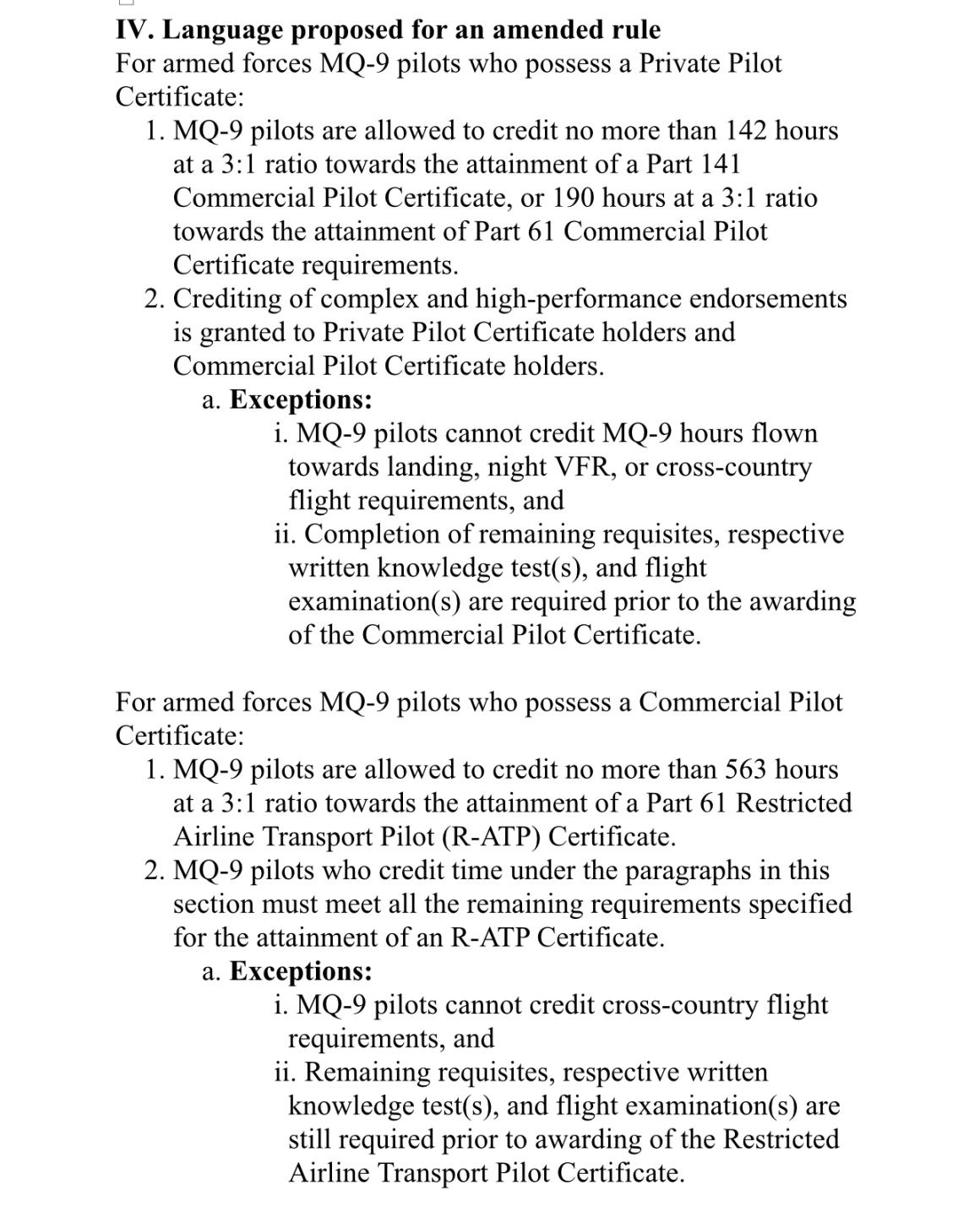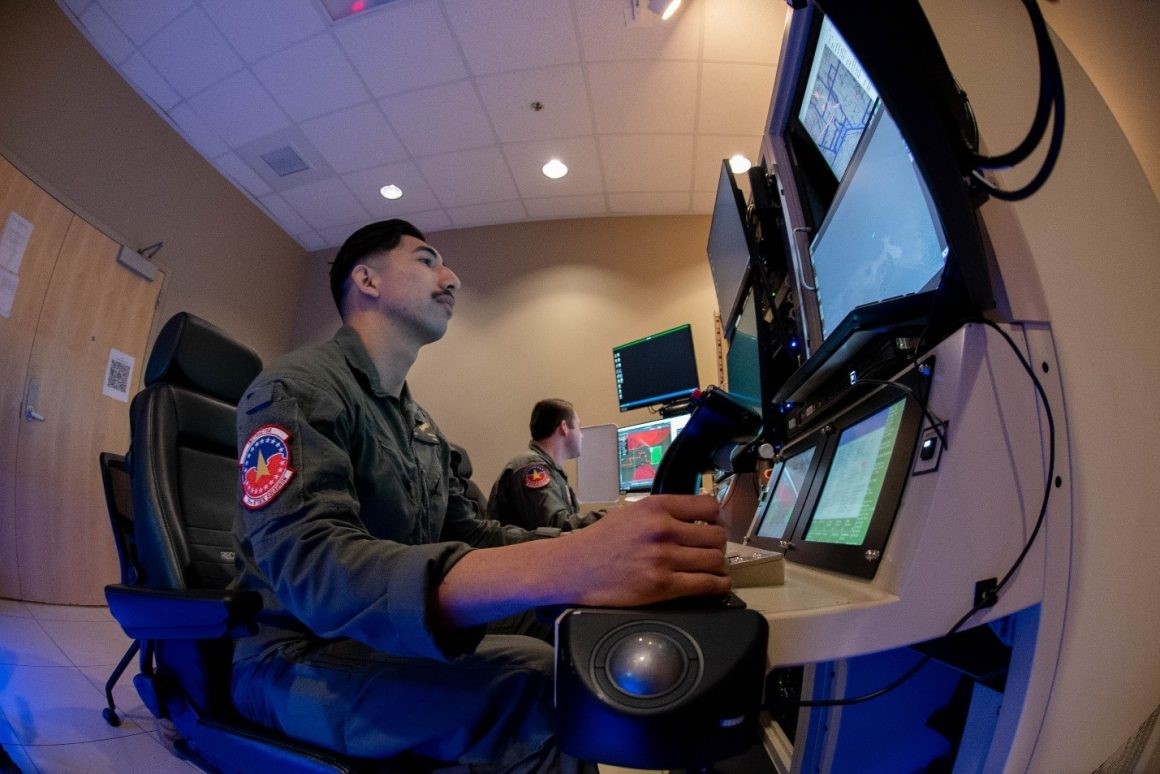ALPA should not block RPAs from becoming r-ATPs


Below is a superb article by Mike Killian in AVGEEKERY.COM; the author found an important document in the FAA Petition for Rulemaking docket, an obscure venue in Federal Register nominal reality. The petition identified was submitted by a USAF MQ-9 Reaper drone pilot. According to the FR search function, this is one of 93 documents there and per an AI search, this is one of 53 requests submitted by a private citizen. The highly qualified, rigorously trained and exceptionally experienced military UAS pilot has proposed a well-crafted set of equivalences between specific Reaper experiences and time towards earning an ATP rating.
The docket includes 50 comments from the general public in the 90 days since publication of the petition. Only 2 express opposition. WHAT IS REMARKABLE IS THAT ALPA HAS NOT SUBMITTED THEIR VEHEMENT OPPOSITION!!!
That exclamation demands explanation.
For months, the battle between ALPA and the airlines over pilots with ATP certificates has been headline news in both mass and aviation trade media. The union asserts that there is no shortage while the airlines state categorically that the statutorily imposed (without any justification) 1,500 hour minimum has deterred potential cockpit employees from qualifying. Legislative efforts to reverse this rule which exceeds all other nation’s standards have been met with an ALPA firestorm; Sen. Duckworth has lent her “weight” to this civil aviation issue. Two retired FAA Administrators, also ALPA members, recommended an improvement to the training pedagogical syllabus, a modification which ALPA deemed an anathema to safety.
The union silence is deafening in comparison to these written comments drawn to the docket:
- “I am a FAA Commercial ASEL and AMEL licensed pilot and have been a USAF RPA pilot (MQ-9) for the past 5 years. I have flown over 400 hours in “manned aircraft” and I have over 1,700 hours in RPAs. I am also a Senior in Liberty University’s B.S. in Aviation program.
I am in a unique position where I have experience in both manned and unmanned aircraft. There is more overlap between the two than I think people realize. I can say with certainty that my RPA experience has made me a better pilot of manned aircraft. I had over 1,000 RPA hours when I earned my Private Pilot License. While I still needed to learn the motor skills required for flying a new aircraft, my experience with airmanship, aerodynamics, emergency procedures, weather, CRM and systems knowledge stayed with me... - USAF MQ-9 pilots perform frequent flight operations both in the NAS and worldwide, integrating with other civilian aircraft regularly. This includes flying pattern work and integrating with GA traffic, performing transcontinental and oceanic flights OCONUS as well as flying ultra-long haul routes along international airways and in Class II airspace. I personally have experience performing 8 hour transits across complex ICAO airspace, performing multiple FIR boundary crossings and integrating with international air traffic controllers while operating the MQ-9.
- We complete crew resource management training, have annual flight evaluations on instrument proficiency, emergency procedures and normal procedures. It is long overdue for medically qualified RPA pilots to have their flight training and skills translate to flying in the civilian sector.
- …there is little substitution for real-world manned pilot experience, however, the training that is involved to become a military RPA pilot is very structured and closely similar to their manned counterparts. At the start of training, all RPA pilots go through IFT in Pueblo, CO, where they receive 40 hrs of manned flying experience in the DA-20. From there, RPA pilots continue on to Undergraduate Remote Pilot Training (URT) where they spend 13 weeks learning how to fly the T-6 in a sim only program. Though they are not physically flying the airplane, students are still taught airmanship, decision making, emergency procedures, how to create and file a flight plan, fuel planning, VFR/IFR navigation including arrivals, departures, and instrument approaches, communication with ATC, and how to adhere to all FAA and ICAO procedures. Students are tested on rules, regulations, systems knowledge, and airmanship as are their manned counterparts. Upon completion of the course, students move on to complete a 5 week Remote Fundamentals Course (RFC) and then move on to their Initial Qualification Training (IQT).
- Military aviators bring a few things to the table. They’re screened for talent and aptitude, they pass rigorous training standards, training takes 1-2 years, and the quality of training is very high. While it may be best for the FAA to present their R-ATP standards and see if RPA pilots meet them, at a glance, I would definitely say they do.
I see military RPA training as much more valuable than the 1000-hour restricted ATPs granted from online schools. Many of us are taking these courses and completing them with our eyes closed. I completed my instrument rating in 3 weeks flying around my work schedule; all of my skills held from training and I could’ve taken my checkride after a few days of brushing up.
We complete regular CRM, instrument, and physiology training annually, on top of our annual checkride and emergency procedures simulator exam. We have extensive multi-crew training and experience. Most of us meet our initial service requirement with 2000-3000 MQ-9 hours. The airmanship, ADM, and general judgment on how to build situational awareness and make decisions is what should grant us the R-ATP. We are screened, tested, and held to strict safety standards…”
Optimistically, the lack of any union opposition may signify that these aviation professionals recognize the equivalent competence of these MQ-9 pilots; however, cynically, one may infer that the union leaders whose opinions are considered ex cathedra by DOT, and they need not publicly oppose the MQ-9 pilots. Ex parte comments to the Secretary will do.
Petition Asks FAA to Credit MQ-9 Pilot Hours Towards Certifications

A petition filed with the FAA last month is requesting an update to credit military MQ-9 Reaper pilot hours towards FAA COMMERCIAL AND RESTRICTED AIRLINE TRANSPORT PILOT CERTIFICATES. This limited change would reduce the total hours required for some military pilots to obtain a restricted or full Airline Transport Pilot (ATP) licences. Supporters also want other Group 5 UAVs (full flight controls, integrated into US and international airspace) included.

Flying a Group 5 UAV is similar to piloting a conventional aircraft with a full set of controls, instruments, and radios. One of the only differences between a UAV and crewed aircraft is that the UAV pilot’s life is not in danger, nor are they flying people. Pilots still conduct systems checks, fuel planning, airspace planning, weather planning, communication and most other tasks typically associated with professional flight. They also fly the aircraft in a bay not unlike a simulator. They adhere to all FAA and ICAO flight rules and communicate with the appropriate ATC agencies in the airspace where they fly. The aircraft they pilot is also much more complex than a traditional drone, small UAV or even a single engine Cessna. So, the question is, why is the experience considered invalid for professional licenses like an ATP?
Petition details

The petition (Docket (FAA-2023-1847) was filed by a USAF drone pilot named Tyler Jackson. And he makes some interesting observations. Some screenshots below:

Jackson notes that MQ-9 pilots execute the same duties as their crewed aircraft counterparts. They operate and control the Reaper with traditional aircraft controls and have all the equipment available and displayed to them for day/night VFR and IFR. They perform, supervise, or direct navigation, surveillance, reconnaissance, and weapons employment operations and have mastered all aspects of advanced aviation. The USAF would not give them Reapers to fly otherwise.
He also notes that MQ-9 pilots have the same responsibilities as their crewed military counterparts. They are graded against many of the same general evaluation criteria and undergo evaluation on an annual basis in the instrument, qualification, mission, and emergency procedure areas for their aircraft while being held to the same rigorous evaluation criteria. You can read more about that in the petition hyperlinked above.

Reaper pilots are well versed in theory of flight, air navigation, meteorology, flying directives, aircraft operating procedures, and mission tactics.
The petition also offers exceptions (see below).

MQ-9 pilots would help with the pilot shortage
“The exorbitant cost of obtaining flight certificates, whether at the Commercial or ATP levels persists, creating obstacles for potential manned pilot vacancies,” says Jackson in the petition. He adds, “Due to the unconventional nature of flying remotely piloted group 5 aircraft and heavy reliance on simulator-based training during undergraduate flight training for MQ-9 pilots, crediting MQ-9 flying hours towards FAA flight certificates may allow for greater flexibility and experimentation in the aviation industry.”According to a 2014 Government Accountability Office report, the cost to train a crewed aircraft pilot costs over 8.5 times more than a UAV pilot. There is no lack of interest to pursue aviation careers, but the costs are the major roadblock for many who would otherwise pursue.

Jackson believes the proposed action could encourage adoption of alternative training methodologies, technologies, and approaches to civilian pilot education. Doing so could lower the costs for aspiring pilots by making training and education more affordable.

“The talent pool from the MQ-9 community is vast and could help pilots combine their full breadth of diverse experience and technologically advanced training to be great applicants for future FAA pilot shortages-especially when these applicants may only need 1/3 of their MQ-9 hours to fill the gap in hours to qualify for their restricted ATP,” says a former USAF pilot on the petition. “It has been a shame for many years to not allow these qualified candidates to have any credit for their diversity of well-rounded experience.”

Killian is a full time aerospace photojournalist, covering both spaceflight and military / civilian aviation and producing stories, original images and reporting for various media and publishers. For Avgeekery, he serves as an assistant editor. Over the last 12 years his assignments have brought him onboard NASA’s space shuttles, flying jets into solar eclipses, onboard aircraft carriers, working with the Blue Angels and flying in almost every vintage warbird that still exists. When not working he enjoys spending time with family, traveling, scuba diving, storm chasing, hiking, kayaking, jet skiing and basically anything cool, as well as watching planes of course.